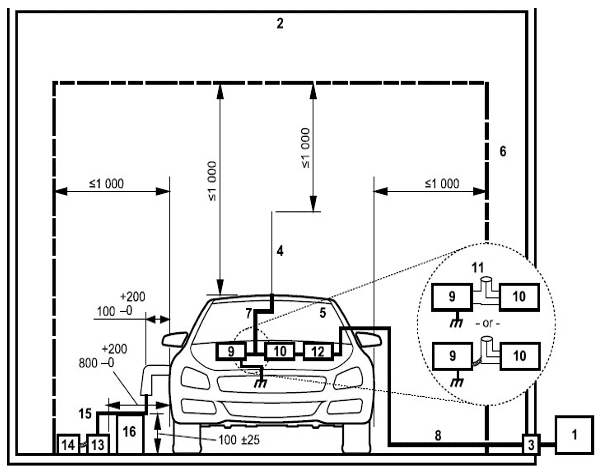
Introduction to CISPR 25
CISPR 25 is an international standard established by the International Special Committee on Radio Interference (CISPR), a part of the International Electrotechnical Commission (IEC). It specifies limits and test methods for electromagnetic emissions from electrical and electronic components in vehicles, boats, and internal combustion engines.
This standard plays a crucial role in ensuring that electronic devices within vehicles do not interfere with onboard radio reception or other vehicle systems.
Why Is CISPR 25 Important?
As modern vehicles incorporate more electronic systems, the potential for electromagnetic interference (EMI) rises. CISPR 25 provides a unified framework for testing and limiting these emissions, helping to:
-
Prevent malfunction of critical systems (e.g., airbags, engine controls)
-
Maintain clear and reliable radio, GPS, and communication signals
-
Ensure overall compliance with EMC (Electromagnetic Compatibility) regulations
Who Needs to Comply with CISPR 25?
Compliance is essential for:
-
Automotive manufacturers
-
OEM suppliers
-
Design engineers
-
Component manufacturers for vehicles, marine engines, and off-road equipment
Any electrical/electronic module that operates within or near a vehicle may require CISPR 25 validation.
Scope of CISPR 25
CISPR 25 covers both radiated and conducted emissions and applies to:
-
Vehicles powered by internal combustion engines, hybrid systems, or electric drives
-
Equipment used in these vehicles
-
Systems interacting with onboard radios, navigation, or telematics
It specifically focuses on protection of in-vehicle receivers from interference, making it critical for ensuring driver and passenger safety and communication reliability.
Key Test Categories in CISPR 25
CISPR 25 outlines several test types:
1. Conducted Emissions Testing
-
Measured from 150 kHz to 108 MHz
-
Focuses on the noise conducted along power and signal lines
-
Ensures emissions don’t disrupt audio, navigation, or communication equipment
2. Radiated Emissions Testing
-
Measured from 150 kHz to 2.5 GHz
-
Evaluates emissions radiating from the device through the air
-
Antennas are used to detect electromagnetic fields from the EUT (Equipment Under Test)
3. Component Level Testing
-
Conducted in shielded rooms or anechoic chambers
-
Simulates actual installation environments in the vehicle
4. Vehicle-Level Testing
-
Sometimes necessary when component-level testing doesn’t reveal full interference scenarios
CISPR 25 Test Setup and Environment
To ensure reliable and repeatable results, CISPR 25 requires:
-
Shielded test chambers to eliminate external EM interference
-
Ground plane test benches with defined cable routing
-
Proper positioning of antennas at standardized distances
-
Ambient noise monitoring to confirm acceptable test conditions
CISPR 25 Frequency Ranges
| Emission Type | Frequency Range |
|---|---|
| Conducted Emissions | 150 kHz to 108 MHz |
| Radiated Emissions | 150 kHz to 2.5 GHz |
CISPR 25 Limits and Classes
The standard defines several limit classes (Class 1 to Class 5) depending on the level of radio receiver protection needed. Class 5 is the most stringent, typically applied to high-end vehicles or sensitive equipment.
| Class | Application Example | Emission Tolerance |
|---|---|---|
| 1 | Basic systems (e.g., fans) | Highest emissions |
| 5 | Radio-sensitive systems | Lowest emissions |
How to Achieve CISPR 25 Compliance
1. Design for EMC
Start with good circuit layout, grounding, and shielding techniques during product design.
2. Pre-compliance Testing
Perform early-stage EMC tests in development to catch issues before final certification.
3. Use Certified Labs
Always use accredited EMC labs with CISPR 25-compliant test environments for official results.
4. Iterate and Fix
Identify and resolve any failures through design improvements, filtering, or shielding.
Common Challenges in CISPR 25 Testing
-
Complex cabling and harness interactions
-
Inadequate shielding or grounding
-
Antenna placement affecting radiated emission results
-
Differences in test setups between labs and manufacturers
CISPR 25 vs CISPR 12 and CISPR 36
| Standard | Focus Area |
|---|---|
| CISPR 12 | Emissions from entire vehicle (on public roads) |
| CISPR 25 | Component emissions inside vehicle affecting radios |
| CISPR 36 | Vehicle emissions up to 400 GHz (newer, broader) |
Future Trends and Updates
-
New revisions may include higher frequency ranges to address 5G and V2X communications
-
Enhanced test methods for EV and hybrid vehicle systems
-
Better guidelines for autonomous vehicle electronics
Conclusion
CISPR 25 is a critical EMC standard for the automotive industry. As vehicle electronics grow in complexity, adhering to its guidelines ensures the safe and interference-free operation of both basic and advanced vehicle systems.
By understanding the requirements, test methods, and compliance strategies, manufacturers can avoid costly recalls, improve product reliability, and meet global market demands with confidence.
FAQs about CISPR 25
Q1: Is CISPR 25 mandatory?
Not legally, but many OEMs require it for component approval.
Q2: Can CISPR 25 testing be done in-house?
Yes, if your facility meets shielding, calibration, and test setup requirements.
Q3: What’s the difference between CISPR 25 Class 3 and Class 5?
Class 5 has stricter limits suitable for radio-reception critical systems, while Class 3 is more lenient.
Q4: Does CISPR 25 cover immunity testing?
No. It’s focused on emissions only. Immunity is covered under ISO 11452 series.





